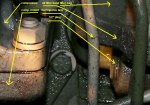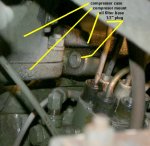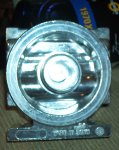Question, is it possible that a 25 micron filter under the right circumstances (as in lower oil pressure) can act as a filter with a lower micron rating operating under a higher pressure?
Ok... a stab at this in the long winded version for everyone reguardless of technical level.
The term micron is purely suggestive... It is used to describe the size of the element inside of a filter but it does not in any way, shape or form mean that said element will filter at that rating because to many factors such as heat, time and pressure are not taken into consideration. Most filters have a "micron rating" and most filters also have a "absolute" and "nominal" micron ratings but even those are suggestive. Both Wix and Fram can make a identical filter from the same element material and one can call it a 10 micron while the other calls it a 30 micron filter... When purchasing a filter this would lead a consumer to believe that one filter in better than the other when it fact they are identical. Nether manufacture is "lying" about the rating, they are just using 2 different means of applying the rating to that filter. This is why you should never trust a filter manufacture that says "ours are designed to X spec and theirs are designed to Y spec, there for ours are better and the other guys is substandard. (Construction method is not being considered here so please ignore that for the moment)...
There are too many variable in filtration to slap a rating on a filter by its element size or construction...
Because of this confusion the industry has slowly and some what reluctantly adapted what is called the "beta" (Bx) rating... which tests and rates a filters efficiency to remove particles of a specific size. This is done by measuring particles before (Nu) and after (Nd) fluid/air passes through a filter... Bx= Nu/Nd for your people whom are smarter than I am... There are several standards and or methods for this testing (ISO4572, ASE 806B, etc) I would suggesting googling filter beta testing and reading up on some of them as me explaining the process or standards would take pages.
There are other variables to beta testing which are added to the parameters which vary depending on a filters designed use such as heat, pressure, flow, etc. Fuel filters might be tested at 150F while oil filters tested 250F (these are just examples, not correct temps)...
The newer commercial filters made by Baldwin, Wix, etc are showing these rating on their filters... For the moment to most of us they look like Chinese scribbled on the side of the filter but I think this will be transcribed over time into a more understandable terminology for the average Joe to understand. Some manufactures are proudly displaying this information and some are avoiding it like a plague as their high dollar racing filter or their low cost "OEM equivalents" don't measure up to the number they would like to see or have us believe as that 10 micron filter is looking more like a 60 micron jobber.
As for flow rates and pressures... Yes depending on the micron rating and how its applied to a filter it is possible that the filter could perform better than actually rated especially if you are using it in a set design. For example the filters Kenny mentioned seeing while he was over. I have been filtering off waste oil to be cut with diesel for the trucks which is being stored up for Aberdeen... When I am pumping oil I am using a Wix filter with a 8 micron absolute / 3 micron nominal rating... (beta is B2>5 under ISO4572)... If you were to slap a "generic micron rating" on the filer it would prolly be in the middle of the road between the two so lets say its 5 micron... Being that I am pumping at 1.2 gpm and about 10 psi which is far under the filters intended range my actual rating would proably be very close to 3...









